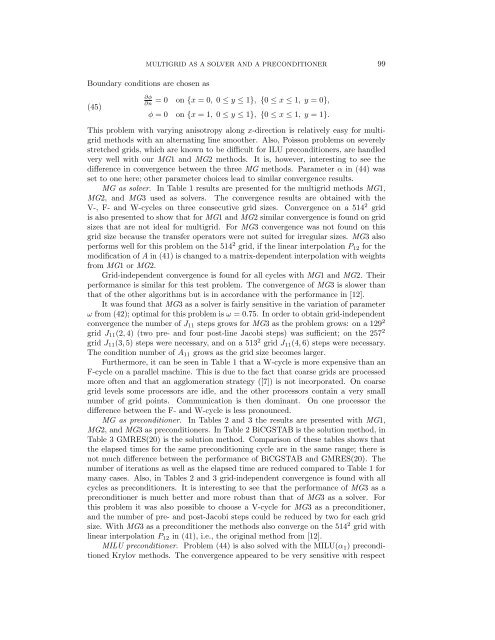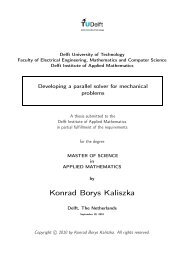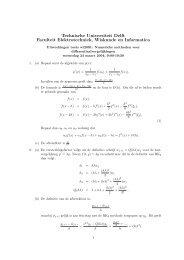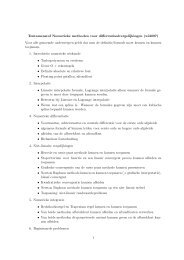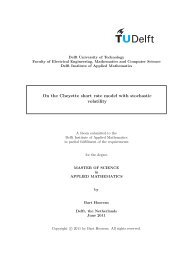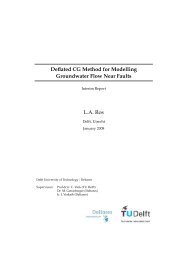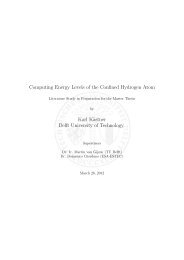AN EVALUATION OF PARALLEL MULTIGRID AS A SOLVER AND A ...
AN EVALUATION OF PARALLEL MULTIGRID AS A SOLVER AND A ...
AN EVALUATION OF PARALLEL MULTIGRID AS A SOLVER AND A ...
Create successful ePaper yourself
Turn your PDF publications into a flip-book with our unique Google optimized e-Paper software.
<strong>MULTIGRID</strong> <strong>AS</strong> A <strong>SOLVER</strong> <strong>AN</strong>D A PRECONDITIONER 99Boundary conditions are chosen as(45)∂φ∂n= 0 on {x = 0, 0 ≤ y ≤ 1}, {0 ≤ x ≤ 1, y = 0},φ = 0 on {x = 1, 0 ≤ y ≤ 1}, {0 ≤ x ≤ 1, y = 1}.This problem with varying anisotropy along x-direction is relatively easy for multigridmethods with an alternating line smoother. Also, Poisson problems on severelystretched grids, which are known to be difficult for ILU preconditioners, are handledvery well with our MG1 and MG2 methods. It is, however, interesting to see thedifference in convergence between the three MG methods. Parameter α in (44) wasset to one here; other parameter choices lead to similar convergence results.MG as solver. In Table 1 results are presented for the multigrid methods MG1,MG2, and MG3 used as solvers. The convergence results are obtained with theV-, F- and W-cycles on three consecutive grid sizes. Convergence on a 514 2 gridis also presented to show that for MG1 and MG2 similar convergence is found on gridsizes that are not ideal for multigrid. For MG3 convergence was not found on thisgrid size because the transfer operators were not suited for irregular sizes. MG3 alsoperforms well for this problem on the 514 2 grid, if the linear interpolation P 12 for themodification of A in (41) is changed to a matrix-dependent interpolation with weightsfrom MG1 or MG2.Grid-independent convergence is found for all cycles with MG1 and MG2. Theirperformance is similar for this test problem. The convergence of MG3 is slower thanthat of the other algorithms but is in accordance with the performance in [12].It was found that MG3 as a solver is fairly sensitive in the variation of parameterω from (42); optimal for this problem is ω = 0.75. In order to obtain grid-independentconvergence the number of J 11 steps grows for MG3 as the problem grows: on a 129 2grid J 11 (2, 4) (two pre- and four post-line Jacobi steps) was sufficient; on the 257 2grid J 11 (3, 5) steps were necessary, and on a 513 2 grid J 11 (4, 6) steps were necessary.The condition number of A 11 grows as the grid size becomes larger.Furthermore, it can be seen in Table 1 that a W-cycle is more expensive than anF-cycle on a parallel machine. This is due to the fact that coarse grids are processedmore often and that an agglomeration strategy ([7]) is not incorporated. On coarsegrid levels some processors are idle, and the other processors contain a very smallnumber of grid points. Communication is then dominant. On one processor thedifference between the F- and W-cycle is less pronounced.MG as preconditioner. In Tables 2 and 3 the results are presented with MG1,MG2, and MG3 as preconditioners. In Table 2 BiCGSTAB is the solution method, inTable 3 GMRES(20) is the solution method. Comparison of these tables shows thatthe elapsed times for the same preconditioning cycle are in the same range; there isnot much difference between the performance of BiCGSTAB and GMRES(20). Thenumber of iterations as well as the elapsed time are reduced compared to Table 1 formany cases. Also, in Tables 2 and 3 grid-independent convergence is found with allcycles as preconditioners. It is interesting to see that the performance of MG3 as apreconditioner is much better and more robust than that of MG3 as a solver. Forthis problem it was also possible to choose a V-cycle for MG3 as a preconditioner,and the number of pre- and post-Jacobi steps could be reduced by two for each gridsize. With MG3 as a preconditioner the methods also converge on the 514 2 grid withlinear interpolation P 12 in (41), i.e., the original method from [12].MILU preconditioner. Problem (44) is also solved with the MILU(α 1 ) preconditionedKrylov methods. The convergence appeared to be very sensitive with respect


